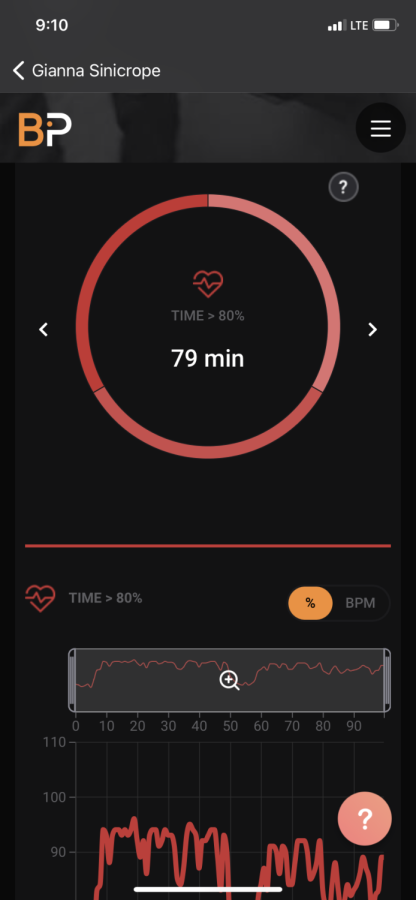Youth sports: how serious is too serious?
Opinions expressed in editorials on The Central Trend are the view of the individual writer and are not the opinion of the entire staff of The Central Trend or the Forest Hills Central staff or administration.
We had gifts that day at practice; a medium-size brown box sat on the aluminum bench. My coach picked out the small, black drawstring pouches and called each of our names, matching our assigned bags. We pulled out a long, black strap of elastic-like material along with a quarter-sized button.
This was my Beyond Pulse. I was expected to wear this smart belt that was monitoring technology for the duration of sessions. No questions asked.
At initial thought, this was great, this was cool. We were just about thirteen and had monitoring gear. This felt professional.
The belt straps below the band of your sports bra and clips in the back. It is decently comfortable and really, has no effect on the physical aspect of playing soccer.
Beyond Pulse tracks a multitude of things. It tracks heart rate, active participation, and distance. After each session, players are sent an email with four circle rings. They fill the amount of the session you met at your expected level as a way to measure your work ethic.
This all seems rather conducive; this could potentially be helpful. However, I find two major flaws.
For one, they taught us little about the app. A majority of my teammates had almost no basic knowledge of what each category meant. Myself, on the other hand, had a slight fitness obsession on occasion and found a great fascination in this type of technology. We rarely discussed what any of this content actually meant, leaving me to interpret it on my own.
A sense of excitement should be linked to working out, not in the numbers it corresponds to. To rephrase, I should want to work out based on the satisfaction the feeling gives me, not my heart rate or how far I went. At this age, I was—and still am—figuring out my relationship with exercise, and I am working to create a healthy one. Attaching numbers and percentages to this could be demeaning.
When or if athletics become a job or you are working at a college level, these tools may be valuable. I just question if introducing these tactics so young affects more than performance.
The second major flaw I encountered is one that I honestly don’t know if I can blame the product itself for.
Coaching staff would send our team GroupMe a picture of our team ranked highest to lowest.
No matter how much my team made fun of the ranking and acted dismissive of it, I was not going to be at the bottom.
If a teammate did worse than a goalie, who did little movement in games and practices, we wouldn’t let it go. Because no matter if they had an off day or that was just their work rate, it was shameful. They should be working harder. That mentality was installed.
Personal data is one thing. Comparing it to each and every other girl on the team is perplexing, adding yet another level of stress and competition to an environment that is already weighing kids down.
Soon after we were acquainted with this new technology, we were introduced to Wendy.
Wendy was a nutritionist.
So, my thirteen year old self sat in a room with thirteen through eighteen year olds, and we all listened to the same health presentation.
In that room, I was made aware that my health needs to be monitored as closely as the girls I idolized towards the back of the room. Those who were nearing the beginning of their college athletic careers. And though I am sure some of the girls took this lightly and informatively, myself, and I assume many others, accepted this as a push to eat better. That what we ate mattered.
Yes, nutrition holds some importance, but what emphasis should it hold at such a young, impactful age?
At this point, I had basically accepted that if I wanted to play collegiate soccer, I had to start training for it now. I wish I could tell my thirteen year old self that isn’t true, I’m sure it would help my future self a lot now.
Maybe indirectly, introducing this variable so early makes it prevalent in the mind. On top of the fact that we did fitness and zooms to work out, we were now pressured to eat a certain way.
To prove my point that these mindsets stick with children, I would definitely state that I can’t quite push these ideologies out, even years later.
One third of adolescent athletes suffer from disordered eating (“Disordered Eating: An Overlooked Health Crisis among Young Athletes”). It’s hard to avoid this percentage when it feels like it is being thrown at you. We are being made aware of the importance of health and fitness without choice. So in many cases—one third of them—it seems children take these reminders further than originally intended.
So sure, maybe the motives are correct, but the outcome isn’t that of predetermination.
This is in no way a dig at my former club soccer experience because nonetheless, I am thankful for all of the positives. I do see the potential benefit these techniques provide. As important as I believe it is to instill healthy habits in children, you must view your audience correctly. The whole program, eighth through twelfth grade, should not be receiving the same messages.
Extremities, recognized as tools, in youth sports need to be observed for their true effects. No matter what you intend to accomplish in the future, children’s minds and beliefs are being molded in the crucial years. Something as vital as how we view health should not be taken lightly.

Gigi is beginning her second year of writing for The Central Trend as a junior this year, and she is starting to fear she will run out of things to say....




























































































Avery Jordan • Dec 17, 2021 at 8:50 am
i literally loveeee this editorial, i’m so glad you addressed such a vital topic like this one
Eva Harshman • Dec 17, 2021 at 8:35 am
Gigi, this is so well written! It’s a serious issue that’s overlooked a lot of the time; I’m so glad you wrote about it.